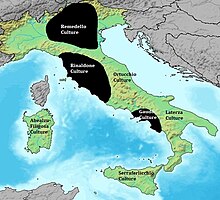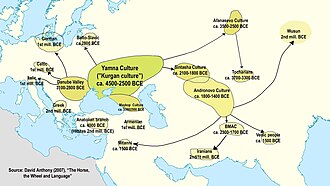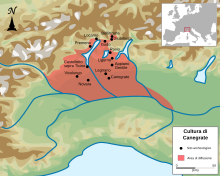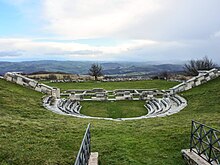Italic peoples

The concept ofItalic peoplesis widely used inlinguisticsandhistoriographyof ancient Italy. In a strict sense, commonly used in linguistics, it refers to theOsco-UmbriansandLatino-Faliscans,speakers of theItalic languages,a subgroup of theIndo-Europeanlanguage family. In a broader sense, commonly used in historiography, all theancient peoples of Italyare referred to as Italic peoples, including those who did not speak Indo-European languages such theRhaetians,LiguresandEtruscans.As theLatinsachieved a dominant position among these tribes, by virtue of the expansion of theRoman civilization,the other Italic tribes adoptedLatinlanguage and culture as part of the process ofRomanization.
Classification
[edit]
The Italics were anethnolinguistic groupwho are identified by their use of theItalic languages,which form one of the branches ofIndo-European languages.
Outside of the specialised linguistic literature, the term is also used to describe theancient peoples of Italyas defined in Roman times, including pre-Romanpeoples like theEtruscansand theRaetians,who did not speak Indo-European languages.[1]Such use is improper in linguistics, but employed by sources such as theEncyclopædia Britannica,which contends that «Italy attained a unified ethnolinguistic, political, and cultural physiognomy only after the Roman conquest, yet its most ancient peoples remain anchored in the names of the regions of Roman Italy —Latium,Campania,Apulia,Bruttium,Lucania,Emilia Romagna,Samnium,Picenum,Umbria,Etruria,Venetia,andLiguria».[2]
History
[edit]Copper Age
[edit]
During theCopper Age,at the same time that metalworking appeared,Indo-European speaking peoplesare believed to have migrated to Italy in several waves.[3]Associated with this migration are theRemedello cultureandRinaldone cultureinNorthernandCentral Italy,and theGaudo cultureofSouthern Italy.These cultures were led by a warrior-aristocracy and are considered intrusive.[3]Their Indo-European character is suggested by the presence of weapons in burials, the appearance of the horse in Italy at this time and material similarities with cultures ofCentral Europe.[3]
Early and Middle Bronze Age
[edit]
According toDavid W. Anthony,between 3100 and 3000 BC, a massive migration of Proto-Indo-Europeans from theYamnaya culturetook place into theDanube Valley.Thousands ofkurgansare attributed to this event. These migrations probably split offPre-Italic,Pre-CelticandPre-GermanicfromProto-Indo-European.[4]By this time theAnatolian peoplesand theTocharianshad already split off from other Indo-Europeans.[5]Hydronymyshows that the Proto-Germanic homeland was in CentralGermany,which would be very close to the homeland of Italic and Celtic languages as well.[6]The origin of a hypothetical ancestral "Italo-Celtic" people is to be found in today's easternHungary,settled around 3100 BC by theYamnaya culture.This hypothesis is to some extent supported by the observation that Italic shares a large number ofisoglossesand lexical terms withCelticandGermanic,some of which are more likely to be attributed to theBronze Age.[3]In particular, using Bayesian phylogenetic methods, Russell Gray and Quentin Atkinson argued that Proto-Italic speakers separated from Proto-Germanics 5500 years before present, i.e. roughly at the start of the Bronze Age.[7]This is further confirmed by the fact that the Germanic language family shares more vocabulary with the Italic family than with the Celtic language family.[8]
From the late third to the early second millennium BC, tribes coming both from the north and from Franco-Iberia brought theBeaker culture[9]and the use of bronze smithing, to thePo Valley,toTuscanyand to the coasts ofSardiniaandSicily.The Beakers could have been the link which brought the Yamnaya dialects fromHungarytoAustriaandBavaria.These dialects might then have developed intoProto-Celtic.[10]The arrival of Indo-Europeans into Italy is in some sources ascribed to the Beakers.[1]A migration across theAlpsfromEast-Central Europeby early Indo-Europeans is thought to have occurred around 1800 BC.[11][12]According to Barfield the appearance ofPolada cultureis connected to the movement of new populations coming from southernGermanyand fromSwitzerland.[13]According toBernard Sergent,the origin of theLigurianlinguistic family (in his opinion distantly related to the Celtic and Italic ones) would have to be found in the Polada and Rhone cultures, southern branches of theUnetice culture.These individuals settled in the foothills of the Eastern Alps and present a material culture similar to contemporary cultures of Switzerland, Southern Germany, and Austria.[14]
In the mid-second millennium BCE, theTerramare culturedeveloped in the Po Valley.[15]The Terramare culture takes its name from the black earth (terra marna) residue of settlement mounds, which have long served the fertilizing needs of local farmers. These people were still hunters, but had domesticated animals; they were fairly skillful metallurgists, casting bronze in moulds of stone and clay, and they were also agriculturists, cultivatingbeans,thevine,wheatandflax.TheLatino-Faliscanpeople have been associated with this culture, especially by the archaeologistLuigi Pigorini.[3]
Late Bronze Age
[edit]
TheUrnfield culturemight have brought proto-Italic people from among the "Italo-Celtic" tribes who remained in Hungary into Italy.[10]These tribes are thought to have penetrated Italy from the east during the latesecond millennium BCthrough theProto-Villanovan culture.[10]They later crossed theApennine Mountainsand settled central Italy, includingLatium.Before 1000 BC several Italic tribes had probably entered Italy. These divided into various groups and gradually came to occupy central Italy and southern Italy.[12]This period was characterized by widespread upheaval in the Mediterranean, including the emergence of theSea Peoplesand theLate Bronze Age collapse.[16]
TheProto-Villanovan culturedominated the peninsula and replaced the precedingApennine culture.The Proto-Villanovans practicedcremationand buried the ashes of their dead in Urnfield-style double-cone shaped funerary urns, often decorated with geometric designs. Elite graves containing jewellery, bronze armour and horse harness fittings were separated from ordinary graves, showing for the first time the development of a highly hierarchical society, so characteristic ofIndo-European cultures.[17]The burial characteristics relate the Proto-Villanovan culture to the Central European Urnfield culture and CelticHallstatt culturethat succeeded it. It is not possible to tell these apart in their earlier stages.[18]Generally speaking, Proto-Villanovan settlements have been found in almost the whole Italian peninsula from Veneto to eastern Sicily, although they were most numerous in the northern-central part of Italy. The most important settlements excavated are those of Frattesina inVenetoregion,BismantovainEmilia-Romagnaand near theMonti della Tolfa,north ofRome.Various authors, such asMarija Gimbutas,associated this culture with the arrival, or the spread, of the proto-Italicsinto theItalian peninsula.[19]

In the 13th century BC, Proto-Celts(probably the ancestors of theLepontiipeople), coming from the area of modern-daySwitzerland,easternFranceand south-western Germany (RSFOUrnfield group), enteredNorthern Italy(Lombardy,easternPiedmontandTicino), starting theCanegrate culture,who not long time after, merging with the indigenousLigurians,produced the mixedGolasecca culture.[20][21]Canegrate had a cultural dynamic, as expressed in its pottery and bronzework, that was completely new to the area and was a typical example of the westernHallstatt culture.[22][23]The name comes from the locality ofCanegratein Lombardy, south ofLegnanoand 25 km north ofMilan,whereGuido Sutermeisterdiscovered important archaeological finds (approximately 50 tombs with ceramics and metallic objects).[24]It is one of the richer archeological sites ofNorthern Italy.[25]
Iron Age
[edit]
In the early Iron Age, the relatively homogeneous Proto-Villanovan culture (1200-900 BC), closely associated with the CelticHallstatt cultureof Alpine Austria, characterised by the introduction of iron-working and the practice of cremation coupled with the burial of ashes in distinctive pottery, shows a process of fragmentation and regionalisation. In Tuscany and in part of Emilia-Romagna, Latium andCampania,the Proto-Villanovan culture was followed by theVillanovan culture.The earliest remains of Villanovan culture date back to circa 900 BC.
In the region south of theTiber(Latium Vetus), theLatial cultureof theLatinsemerged, while in the north-east of the peninsula theEste cultureof theVenetiappeared. Roughly in the same period, from their core area in central Italy (modern-dayUmbriaandSabinaregion), theOsco-Umbriansbegan to emigrate in various waves, through the process ofVer sacrum,the ritualized extension of colonies, in southern Latium,Moliseand the whole southern half of the peninsula, replacing the previous tribes, such as theOpiciand theOenotrians.This corresponds with the emergence of the Terni culture, which had strong similarities with the Celtic cultures of Hallstatt andLa Tène.[26]TheUmbriannecropolis ofTerni,which dates back to the 10th century BC, was identical in every aspect to the Celtic necropolis of the Golasecca culture.[27]
Antiquity
[edit]By the mid-first millennium BC, the Latins ofRomewere growing in power and influence. This led to the establishment ofancient Roman civilization.In order to combat the non-Italic Etruscans, several Italic tribes united in theLatin League.After the Latins had liberated themselves from Etruscan rule they acquired a dominant position among the Italic tribes. Frequent conflict between various Italic tribes followed. The best documented of these are thewarsbetween the Latins and theSamnites.[1]
The Latins eventually succeeded in unifying the Italic elements in the country. Many non-Latin Italic tribes adopted Latin culture and acquired Roman citizenship. During this time Italiccolonieswere established throughout the country, and non-Italic elements eventually adopted theLatinlanguage and culture in a process known asRomanization.[12]In the early first century BC, several Italic tribes, in particular theMarsiand the Samnites, rebelled against Roman rule. This conflict is called theSocial War.After Roman victory was secured, all peoples in Italy, except for theCeltsof the Po Valley, were grantedRoman citizenship.[1]
In the subsequent centuries, Italic tribes were assimilated intoLatinculture in a process known asRomanization.
Theatre
[edit]
Italian peoples such as theEtruscanshad already developed forms of theatrical literature.[28]The legend, also reported byLivy,speaks of a pestilence that had struck Rome, at the beginning, and the request for Etruscan historians. The Roman historian thus refused the filiation from the Greek theater before contacts withMagna Graeciaand its theatrical traditions. There are no architectural and artistic testimonies of the Etruscan theater.[28]A very late source, such as the historianVarro,mentions the name of a certain Volnio who wrote tragedies in theEtruscan language.
Even theSamniteshad original representational forms that had a lot of influence on Roman dramaturgy such as theAtellan Farcecomedies, and some architectural testimonies such as the theater ofPietrabbondanteinMolise,and that ofNocera Superioreon which the Romans built their own.[29]The construction of the Samnite theaters of Pietrabbondante and Nocera make the architectural filiation of the Greek theater understood.
Genetics
[edit]| Part ofa serieson |
| Indo-European topics |
|---|
 |
A genetic study published inSciencein November 2019 examined the remains of sixLatinmales buried nearRomebetween 900 BC and 200 BC. They carried the paternal haplogroupsR-M269,R-311,R-PF7589 andR-P312and the maternal haplogroupsH1aj1a,T2c1f,H2a,U4a1a,H11aandH10.A female from the precedingProto-Villanovan culturecarried the maternal haplogroupsU5a2b.[30]These examined individuals were distinguished from preceding populations of Italy by the presence of about 25–35%steppe ancestry.[31]Overall, the genetic differentiation between the Latins, Etruscans and the preceding proto-villanovan population of Italy was found to be insignificant.[32]
See also
[edit]References
[edit]- ^abcdWaldman & Mason 2006,pp. 452–459
- ^"Ancient Italic people | Etruscans, Latins, & Samnites | Britannica".www.britannica.com.
- ^abcdeMallory 1997,pp. 314–319
- ^Anthony 2007,p. 305
- ^Anthony 2007,p. 344
- ^Hans, Wagner."Anatolien war nicht Ur-Heimat der indogermanischen Stämme".eurasischesmagazin.Retrieved20 July2016.
- ^Gray, Russell D.; Atkinson, Quentin D.; Greenhill, Simon J. (12 April 2011)."Language evolution and human history: what a difference a date makes, Russell D. Gray, Quentin D. Atkinson and Simon J. Greenhill (2011)".Philosophical Transactions of the Royal Society B: Biological Sciences.366(1567): 1090–1100.doi:10.1098/rstb.2010.0378.PMC3049109.PMID21357231.
- ^"A Grammar of Proto-Germanic, Winfred P. Lehmann Jonathan Slocum"(PDF).
- ^p. 144, Richard BradleyThe prehistory of Britain and Ireland,Cambridge University Press, 2007,ISBN0-521-84811-3
- ^abcAnthony 2007,p. 367
- ^"Italic languages: Origins of the Italic languages".Encyclopædia Britannica Online.RetrievedJuly 10,2018.
- ^abc"History of Europe: Romans".Encyclopædia Britannica Online.RetrievedJuly 10,2018.
- ^Bietti Sestieri, Anna Maria (2010).L'Italia nell'età del bronzo e del ferro: dalle palafitte a Romolo (2200-700 a.C.).Roma: Carocci. p. 21.ISBN978-88-430-5207-3.OCLC663998477.
- ^Sergent, Bernard (1995).Les Indo-Européens histoire, langues, mythes.Impr. BCI). Paris: Payot. p. 416.ISBN2-228-88956-3.OCLC708337872.
- ^Pearce, Mark (December 1, 1998). "New research on the terramare of northern Italy".Antiquity.72(278): 743–746.doi:10.1017/S0003598X00087317.S2CID160050623.
- ^Waldman & Mason 2006,pp. 620–658
- ^"Le grandi avventure dell'archeologia (I misteri delle civiltà scomparse) - Libro Usato - Curcio - | IBS".www.ibs.it(in Italian).Retrieved2023-01-08.
- ^Soren, David; Martin, Archer (2015).Art and Archaeology of Ancient Rome.Midnight Marquee Press, Incorporated. p. 9.
- ^M. GimbutasBronze Age Cultures in Central and Eastern Europepp. 339–345
- ^Venceslas Kruta:La grande storia dei celti. La nascita, l'affermazione e la decadenza,Newton & Compton, 2003,ISBN88-8289-851-2,ISBN978-88-8289-851-9
- ^G. Frigerio,Il territorio comasco dall'età della pietra alla fine dell'età del bronzo,inComo nell'antichità,Società Archeologica Comense, Como 1987.
- ^Kruta, Venceslas (1991).The Celts.Thames and Hudson. pp. 93–100.
- ^Stifter, David (2008).Old Celtic Languages(PDF).p. 24.
- ^Agnoletto, Attilo (1992).San Giorgio su Legnano – storia, società, ambiente(in Italian). p. 18.SBNIT\ICCU\CFI\0249761.
- ^Di Maio, Paola (1998).Lungo il fiume. Terre e genti nell'antica valle dell'Olona(in Italian). Corsico: Teograf. p. 100.
- ^Leonelli, Valentina.La necropoli delle Acciaierie di Terni: contributi per una edizione critica(Cestres ed.). p. 33.
- ^Farinacci, Manlio.Carsulae svelata e Terni sotterranea.Associazione Culturale UMRU - Terni.
- ^ab"Storia del teatro: lo spazio scenico in Toscana"(in Italian).Retrieved28 July2022.
- ^"La fertile terra di Nuceria Alfaterna"(in Italian).Retrieved28 July2022.
- ^Antonio et al. 2019,Table 2 Sample Information, Rows 29-32, 36-37.
- ^Antonio et al. 2019,p. 2.
- ^Antonio et al. 2019,p. 3.
Sources
[edit]- Anthony, David(2007).The Horse, the Wheel, and Language: How Bronze-Age Riders from the Eurasian Steppes Shaped the Modern World.Princeton University Press.ISBN978-0-691-05887-0.
- Antonio, Margaret L.; et al. (November 8, 2019)."Ancient Rome: A genetic crossroads of Europe and the Mediterranean".Science.366(6466).American Association for the Advancement of Science:708–714.Bibcode:2019Sci...366..708A.doi:10.1126/science.aay6826.PMC7093155.PMID31699931.
- Cole, Jeffrey(2011).Ethnic Groups of Europe: An Encyclopedia.ABC-CLIO.ISBN978-1598843026.
- Devoto, Giacomo;Buti, Gianna G. (1974).Preistoria e storia delle regioni d'Italia.Florence:Sansoni.
- Devoto, Giacomo (1951).Gli antichi Italici.Florence: Vallechi.
- GP (2001).MultiCultural Review: Dedicated to a Better Understanding of Ethnic, Racial, and Religious Diversity, Volume 10.GP Subscription Publications.ISBN0823997006.
- Mallory, J. P.(1997).Encyclopedia of Indo-European Culture.Douglas Q. Adams.ISBN1884964982.Retrieved23 March2013.
- Minahan, James (2000).One Europe, Many Nations: A Historical Dictionary of European National Groups.Greenwood Publishing Group.ISBN0313309841.
- Moscati, Sabatino(1998).Così nacque l'Italia: profili di popoli riscoperti.Turin: Società Editrice Internazionale.
- Pigorini, Luigi(1910).Gli abitanti primitivi dell'Italia.Rome: Bertero.
- Pop, Ioan-Aurel(1996).Romanians and Hungarians from the 9th to the 14th century.Romanian Cultural Foundation.ISBN0880334401.
- Pop, Ioan-Aurel (1999).Romanians and Romania: A Brief History.East European Monographs.ISBN9735770377.
- Treptow, Kurt W.[in Romanian](1996).A History of Romania.East European Monographs.ISBN0880333456.
- Villar, Francisco(1997).Gli Indoeuropei e le origini dell'Europa.Bologna: Il Mulino.ISBN88-15-05708-0.
- Waldman, Carl; Mason, Catherine (2006).Encyclopedia of European Peoples.Infobase Publishing.ISBN1438129181.
Further reading
[edit]- M. Aberson, R. Wachter, «Ombriens, Sabins, Picéniens, peuples sabelliques des Abruzzes: une enquête historique, épigraphique et linguistique ", in:Entre archéologie et Histoire: dialogues sur divers peuples de l’Italie préromaine, Bern, etc.,2014, p. 167-201.
